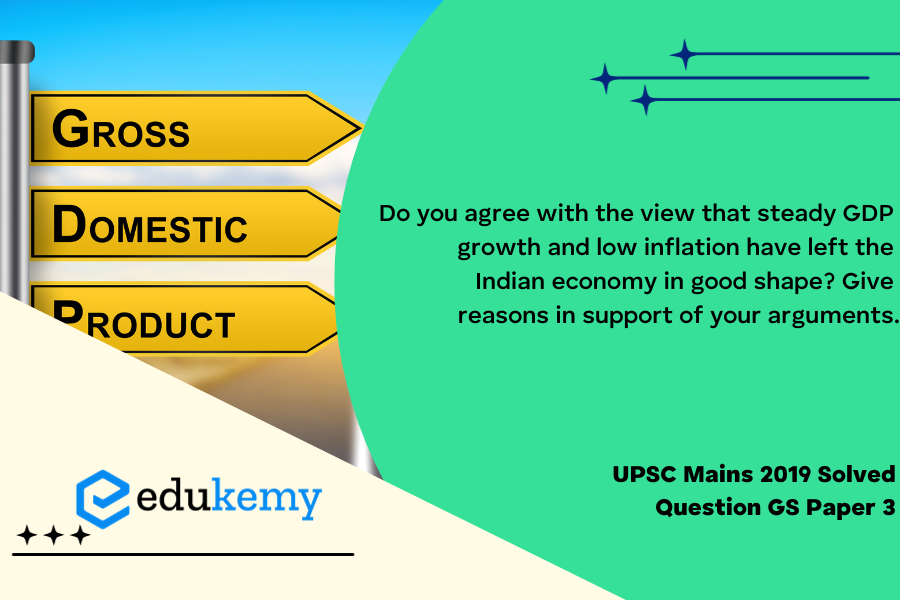The juxtaposition of steady GDP growth and low inflation in the Indian economy has indeed positioned the nation in a favorable economic stance. This perspective is underpinned by the symbiotic relationship between these two key indicators, signaling stability and resilience. The consistent expansion of the Gross Domestic Product (GDP) reflects a robust economic engine, often driven by increased productivity, investments, and consumption. Simultaneously, low inflation acts as a crucial stabilizing force, preventing an erosion of purchasing power and fostering a conducive environment for sustainable growth. In this context, the synergy between steady GDP growth and low inflation contributes to an economic landscape that is not only resilient but also conducive to long-term development. The positive impact is evident in enhanced investor confidence, job creation, and improved living standards. However, it is imperative to scrutinize the nuanced challenges and ensure that the benefits are inclusive, addressing disparities and fostering holistic development.
Tag: Indian economy and issues related to planning, mobilization of resources, growth development and employment.
Contents
Decoding the Question:
- In the Introduction, try to highlight India’s steady GDP growth and Inflation with stats.
- In Body,
- Discuss how steady GDP growth and low inflation have a positive impact on the economy.
- Also, justify the shortcomings of steady but low inflation.
- Try to conclude with the need for a balance between both growth and inflation.
Answer:
The Economic Survey 2018-19 states that the economy witnessed a gradual transition from a period of high and variable inflation to a more stable and low level of inflation in the period 2014-18. However, in the current fiscal quarter, the headline inflation has fallen to the lowest value and also there is a reduction in Gross Value Added (GVA). This has raised various debates around the use of inflation-targeted monetary policy and its impact on the overall economy.

The positive impact of steady growth rate and lower inflation:
- Increasing Income of the Public and Reduced Expenditure: Lower inflation rates are directly for the interests of consumers. Lower inflation means lower food prices and lower prices on essential commodities. People do not have to spend more than the mandatory expenditure. Hence the percentage of income saved will be higher. Similarly, the steady GDP Growth is quite healthy for the economy. As growth keeps on occurring steadily, public income gets increased. Over some time, this extra income accumulates, leading to more chances for spending.
- Increased Output: Low inflation has always been good for an economy, especially in India, which needs steady and sustainable growth, higher investment in the economy, increased confidence among investors, etc. to achieve higher economic growth targets.
- Creation of Assets: So, steady growth helps in the steady flow of external investments in the form of FDI and FII, which help in providing the required impetus for economic growth. Similarly, when the inflation rate is low, people are left with more money in their hands after spending on essential commodities. The savings money is used for creating assets in the form of real estate, gold or automobiles.
- Macroeconomic Stability: A low inflation rate improves macroeconomic stability by keeping the exchange rate stable, and improving exports and imports. Stable interest rates will improve investment which further leads to multiplier effects.
- Reforms Facilitator: Steady economic growth helps the government to push for economic reforms like Goods and Service Tax.
- Improve Tax Collection: Steady economic growth and low inflation improve tax collection (both direct and indirect) which further improves the spending of the government in infrastructure development and social infrastructure etc. Improved revenue prospects for the government will also help in improved contribution in various social sector schemes.
- Employment Generation:The steady GDP growth directly helps in the generation of employment. With higher output and positive economic growth, firms tend to employ more workers creating employment. It helps in promoting labor-intensive industries.
Insufficient Economic Parameters:
- Hamper investment: Constant lower levels of inflation will deter private investment in an economy.
- Unemployment: When companies see lower or negative inflation and there is no expected profit gaining in the business then corporates cut further expansion and investment which hampers employment generation. Jobless growth: When steady economic growth has not transformed into enough employment generation.
- Farmer’s loss: Lower inflation has resulted in poor earnings for farmers. This has negatively impacted the rural economy and resulted in agrarian distress.
- Fall in consumption demand: The decreasing Consumer Price Index (CPI) clearly shows the receding disposable income in rural areas which can be seen in the Q2 GDP growth rate falling to 5%.
- Reduction in investment: The contraction of the economy due to falling consumption has reduced the scope of further investment.
- Double Balance Sheet Problem: Due to the slowdown, various corporates are facing the revenue shortage to pay back the interest, leading to the NPA problem faced by the banks.
- Revenue Shortfall of the Government: Due to less income generation in the economy, direct tax revenue has receded. This reduces government legroom for more public expenditure.
Hence, high and steady economic growth is certainly desirable. But low inflation is not always good. Therefore, the government should perhaps aim for low inflation but have a degree of flexibility if this appears unsuitable to the economy. A balance between both economic growth and inflation is needed for overall economic development. Policymakers must understand the root cause of inflation and plan the economy accordingly.
In case you still have your doubts, contact us on 9811333901.
For UPSC Prelims Resources, Click here
For Daily Updates and Study Material:
Join our Telegram Channel – Edukemy for IAS
- 1. Learn through Videos – here
- 2. Be Exam Ready by Practicing Daily MCQs – here
- 3. Daily Newsletter – Get all your Current Affairs Covered – here
- 4. Mains Answer Writing Practice – here


